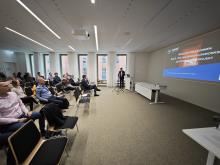Whether for steel and glass production or in many other industrial plants: burners that convert hydrogen into heat instead of natural gas in the future are - alongside electricity from renewable energies - the basis for a successful energy transition in industry. But how can this work when hydrogen has significantly different properties to natural gas? Over the past three years, a research project at TU Bergakademie Freiberg has been investigating solutions for industrial furnaces, industrial heating systems and furnaces. The team from the Chair of Gas and Heating Technology and its partners present the results at the end of the project in Freiberg.

The team and its partners from industry and science investigated the key issues for the use of hydrogen in the energy transition's lead technology project. Prof Hartmut Krause summarises the results: "With this project, we were able to show that various basic types of industrial firing systems can be converted from natural gas to hydrogen. The conversion costs are manageable. In some cases, we found surprisingly positive effects for resource efficiency in thermal process technology using hydrogen as an energy source."
The project investigated the design of the burners, the control and regulation of the flame and the stability of materials for the thermal insulation and equipment of the new hydrogen furnaces. "It is important to consider these three approaches together, as this is the only way to ultimately present a comprehensive assessment for hydrogen operation," says Prof Hartmut Krause. "In conjunction with other research institutions and industry, the approach presented thus offers enormous potential," says the head of the research project.
Burners with ultra-low emissions
In the technical centre, the team first took a close look at hydrogen combustion: "Because exactly how the gas is converted in an industrial burner has an impact on the formation of pollutants and thus the emissions of the production processes," explains Dr Sven Eckart from the Chair of Gas and Thermal Engineering at TU Freiberg. In the project, three basic types of industrial burners in several performance classes were measured in detail and retrofitted. According to the results, existing industrial furnaces can be operated safely and stably with hydrogen with minor adjustments. Nevertheless, nitrogen oxide emissions are kept at a low level. Despite higher flame temperatures during hydrogen combustion, the cause of nitrogen oxide formation, lower emissions were achieved than with natural gas. The research project thus provides burner manufacturers with design recommendations for efficient and low-emission burners.
Controlling combustion safely
For industrial applications, the control systems for the combustion of fluctuating hydrogen proportions must also be adapted. To this end, researchers at the DBI Gas Technology Institute Freiberg have developed two models for controlling the gas-air mixture and tested them on demonstrators. Together with industrial partners, they are now transferring the new control strategies into applications for burners with hydrogen or hydrogen components. "With the new control principles, we are able to achieve highly efficient combustion even with fluctuating hydrogen proportions," states Marcus Wiersig from research partner DBI.
Materials for hydrogen furnaces
In another sub-project, the researchers investigated how refractory materials, steels, ceramics and new material combinations react to hydrogen and its exhaust gases. "After all, hydrogen can only be used in industrial furnaces if their stability and service life are not restricted," says Dr Sven Eckart. "With an evaluation matrix, the project now offers plant operators and manufacturers an easy-to-use concept for the use of high-temperature materials in hydrogen-fuelled industrial furnaces." The team led by Chris Fritsche at the Chair of Gas and Thermal Engineering was able to demonstrate significantly better protection mechanisms for some important materials than in natural gas operation.
On the research project
At the conclusion of the lead technology project of the SME Research Network (IGF) "TTgoesH2 - Integration of hydrogen as a climate-neutral energy carrier in industrial and commercial thermal process technology", representatives from over 40 companies who have actively participated in the project committee over the past three years and contributed to the development of innovative hydrogen technologies in the high-temperature range will come together at TU Freiberg. The Federal Ministry for Economic Affairs and Climate Protection funded the project with a total of 1,500,000 euros.
The following research institutions were involved: TU Bergakademie Freiberg, Chair of Gas and Heat Engineering (coordination), DBI - Gastechnologisches Institut gGmbH Freiberg, RWTH Aachen University, Institute for Industrial Furnace Construction and Heat Engineering, Gas and Heat Institute Essen e.V., University of Duisburg-Essen, Institute of Combustion and Gas Dynamics, Leibniz Institute for Materials-Oriented Technologies.
Questions answered: Hartmut [dot] Krause [at] iwtt [dot] tu-freiberg [dot] de (Prof. Hartmut Krause)